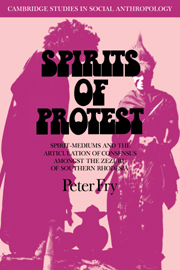 Spirits of Protest
Spirits of Protest Published online by Cambridge University Press: 08 March 2010
The dynamic model proposed to take account of the operation of the spirit-mediums of Chiota Tribal Trust Land was felt necessary in order to make sense of a very complex reality. The general picture is of a vital religious organisation against the background of a dynamically changing social situation. To a considerable extent the flexibility and uncertainty of the ‘traditional’ religion of Chiota mirror similar characteristics in the mundane sphere of politics and economics. As was shown in chapter 1 Chiota's close proximity to Salisbury means that the people of Chiota are the first to be affected by the political and economic upheavals so much a characteristic of Southern Rhodesia in the last 15 years.
The Korekore of Mount Darwin District are much further removed from these upheavals, and Garbett has shown that their system of spirit-mediumship is much more tightly controlled than that of the Zezuru and that hierarchies of spirits and mediums really exist. In view of this marked difference between the religious organisation of two Shona-speaking peoples it is as well to embark on the task of comparative analysis of Shona institutions.
The Korekore
The Korekore are organised into small chiefdoms in the Zambesi Valley, successors of the once great Munhumutapa Kingdom (Korekore ‘royals’ claim patrilineal descent from Mutota, whom Abraham (1959 : 59–84) has identified with Munhumutapa.) Korekore chiefdoms, therefore, have an historical unity.
Korekore chiefdoms are loosely structured around these royal lineages. They are composed of small hamlets which are short lived and prone to fission.
To save this book to your Kindle, first ensure [email protected] is added to your Approved Personal Document E-mail List under your Personal Document Settings on the Manage Your Content and Devices page of your Amazon account. Then enter the ‘name’ part of your Kindle email address below. Find out more about saving to your Kindle.
Note you can select to save to either the @free.kindle.com or @kindle.com variations. ‘@free.kindle.com’ emails are free but can only be saved to your device when it is connected to wi-fi. ‘@kindle.com’ emails can be delivered even when you are not connected to wi-fi, but note that service fees apply.
Find out more about the Kindle Personal Document Service.
To save content items to your account, please confirm that you agree to abide by our usage policies. If this is the first time you use this feature, you will be asked to authorise Cambridge Core to connect with your account. Find out more about saving content to Dropbox.
To save content items to your account, please confirm that you agree to abide by our usage policies. If this is the first time you use this feature, you will be asked to authorise Cambridge Core to connect with your account. Find out more about saving content to Google Drive.